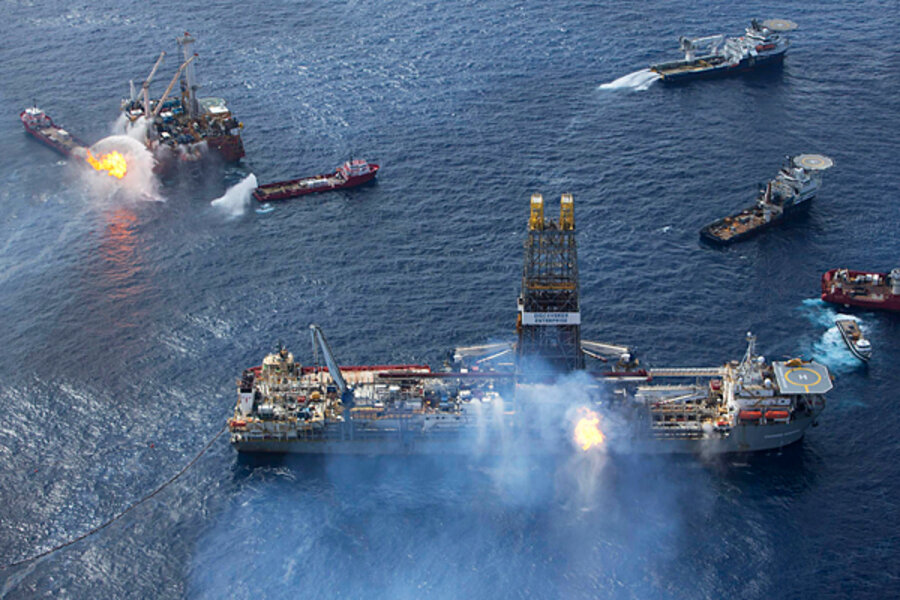How BP wants to start over in bid to contain Gulf oil spill
Loading...
Tropical storm Alex comes just as the Coast Guard and BP are preparing to make the oil-collection system at the leaking well on the sea floor more hurricane-ready.
For now, it appears as if Alex will pass far west of the Gulf oil spill. But even before Alex developed, the end of June and the beginning of July was shaping up to be a crucial moment in BP’s bid to collect all the oil gushing into the Gulf of Mexico.
During the next two to three weeks, BP will make major changes at and above the well. It will bring in a host of new ships to replace those currently on site and radically change the underwater architecture that has captured 15,000 to 25,000 barrels of oil (630,000 to 1 million gallons) daily during much of the past month.
IN PICTURES: Response to the oil spill on the Gulf Coast
In the process, the company will make it easier for ships to connect to and disconnect from its network of subsea pipes in the event of a hurricane.
Here is a snapshot of what is happening now and how that is expected to change during the next few weeks.
What is going on now
Currently, two ships are collecting about 25,000 barrels of oil a day combined.
The first is the Discoverer Enterprise, which can process – in other words, separate from the water and natural gas also captured – about 15,000 barrels of oil a day. This oil is being sent to shore on tankers, and BP is donating revenues from the oil to a Gulf wildlife fund.
The second ship is the Q4000, which can only burn the oil it collects. It is currently burning about 10,000 barrels of oil a day.
Each of these ships collects oil flowing through the failed blowout preventer on the sea floor in a different way, which is important for what comes next.
The Discoverer Enterprise is connected to the containment cap, which is fitted atop the stump of the riser pipe that led to the Deepwater Horizon before the rig sank.
The Q4000 is connected to a valve on the side of the blowout preventer – the choke line, which was used to pump in drilling mud during the failed “top kill” operation.
Both ships, however, are connected to the blowout preventer via fixed riser pipes that would have to be disconnected when ships went to shore during a hurricane.
Making the system more hurricane-ready
BP’s primary goal in the weeks ahead is to replace these fixed riser pipes with flexible riser pipes that would remain connected to the well during a hurricane, their mouths floating about 300 feet below the surface.
Ships returning after a hurricane could more easily connect to a floating riser pipe just below the surface than with the various blowout preventer valves a mile down.
The first flexible riser pipe is almost finished. It will be attached to a second valve on the side of the blowout preventer known as the kill line. A new ship called the Helix Producer will connect to this flexible riser.
The Helix Producer can process about 25,000 barrels of oil a day. It is expected to come online Tuesday.
On Wednesday, BP and the Coast Guard are expected to decide whether to greenlight a project that would remove the containment cap and replace it with a larger cap connected to two flexible riser pipes.
The replacement cap, called an overshot tool, would not sit atop the stump of the original riser pipe, but would bolt directly to the blowout preventer, perhaps creating a better seal.
With two flexible riser pipes, the tool would also allow for two ships to connect to it, potentially doubling capacity. Media reports suggest that the two ships would be the Discoverer Enterprise and the Toisa Pisces.
Several tankers, including the Loch Rannoch, would ferry the processed oil to shore.
This system, if given the go-ahead Wednesday, would be in place by mid-July.
Around the same time, BP plans to replace the Q4000 and its fixed riser pipe with the Clear Leader and a new flexible riser pipe to the choke line.
In total, the new system would be able to process about 80,000 barrels daily.
This system to collect oil at the well is separate from the efforts to skim the oil slick on the surface. In those efforts, the A Whale supertanker is on its way to the Gulf. The supertanker could skim 500,000 gallons of oil-contaminated water from the surface of the Gulf daily.
IN PICTURES: Response to the oil spill on the Gulf Coast
Related:





